英语人教版九年级全册中考英语阅读理解专题课教学设计
- 格式:pdf
- 大小:2.05 MB
- 文档页数:9
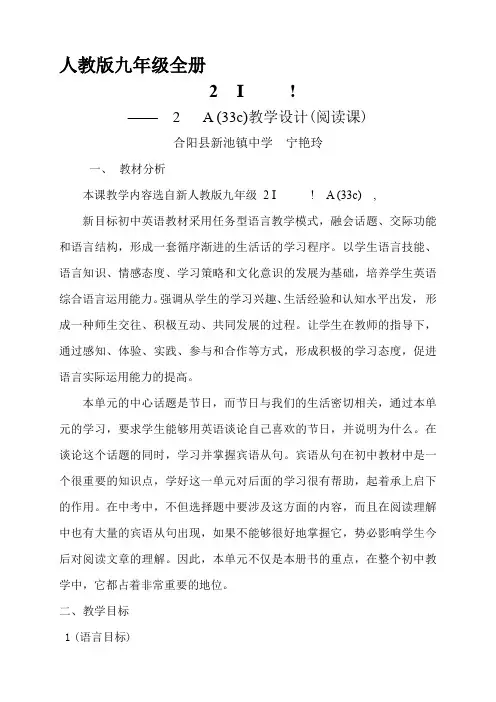
人教版九年级全册2 I !—— 2 A (33c)教学设计(阅读课)合阳县新池镇中学宁艳玲一、教材分析本课教学内容选自新人教版九年级 2 I ! A (33c) ,新目标初中英语教材采用任务型语言教学模式,融会话题、交际功能和语言结构,形成一套循序渐进的生活话的学习程序。
以学生语言技能、语言知识、情感态度、学习策略和文化意识的发展为基础,培养学生英语综合语言运用能力。
强调从学生的学习兴趣、生活经验和认知水平出发,形成一种师生交往、积极互动、共同发展的过程。
让学生在教师的指导下,通过感知、体验、实践、参与和合作等方式,形成积极的学习态度,促进语言实际运用能力的提高。
本单元的中心话题是节日,而节日与我们的生活密切相关,通过本单元的学习,要求学生能够用英语谈论自己喜欢的节日,并说明为什么。
在谈论这个话题的同时,学习并掌握宾语从句。
宾语从句在初中教材中是一个很重要的知识点,学好这一单元对后面的学习很有帮助,起着承上启下的作用。
在中考中,不但选择题中要涉及这方面的内容,而且在阅读理解中也有大量的宾语从句出现,如果不能够很好地掌握它,势必影响学生今后对阅读文章的理解。
因此,本单元不仅是本册书的重点,在整个初中教学中,它都占着非常重要的地位。
二、教学目标1(语言目标)(1)熟练掌握本单元词汇:, , , (, ) , (, ), , , , , .(2)熟练掌握下面有用的句子:...2(技能目标)进一步巩固宾语从句,并能熟练应用这些句型谈论节日。
3(情感目标)通过对传统中秋节的学习,培养学生热爱文化、主动学习文化的兴趣,陶冶思想情操。
三、(教学重难点)教学重点:掌握本课词汇,培养学生的阅读技能。
教学难点:学会运用宾语从句表达自己的情感。
四、(教法与学法)教学方法:教师通过,,等任务和活动,创设一种互动、竞争的课堂,让学生在轻松愉悦的氛围中提高阅读技能。
学习方法:借助单词教学、复述故事、及头脑风暴输出重点短语这三大活动,进行小组合作学习,自主探究、主动参与到竞争中来。
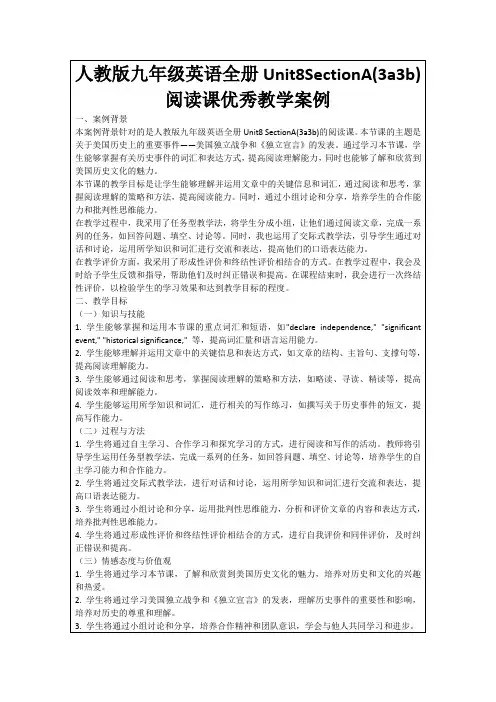
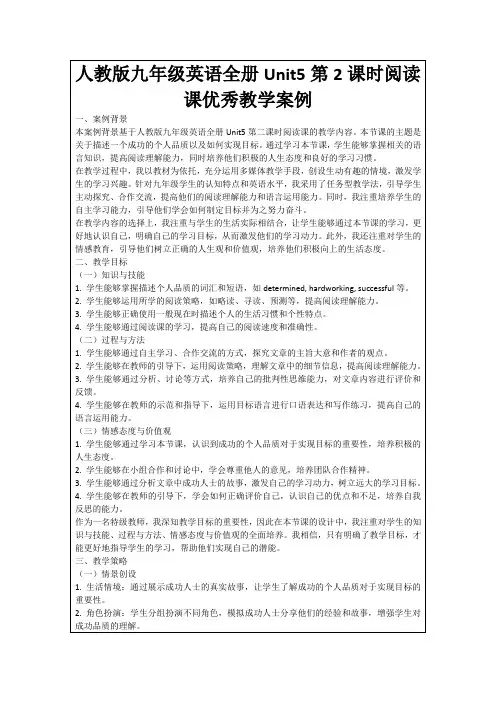

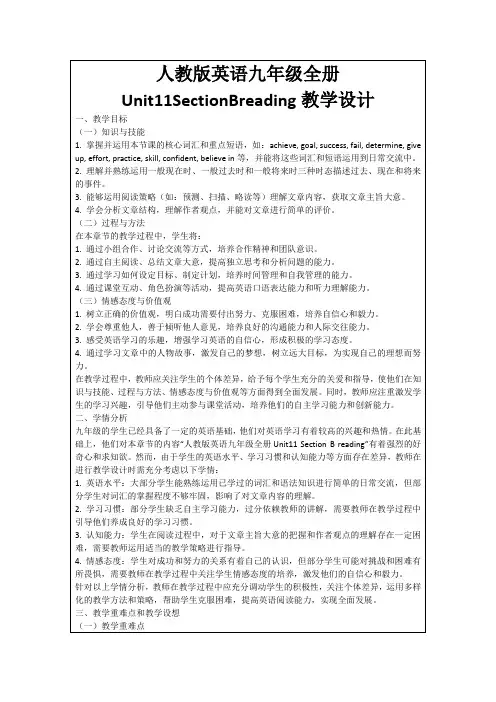
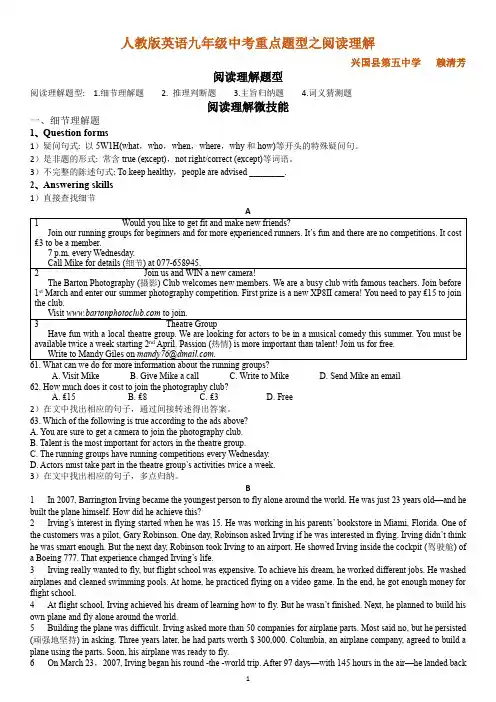
人教版英语九年级中考重点题型之阅读理解兴国县第五中学赖清芳阅读理解题型阅读理解题型: 1.细节理解题 2. 推理判断题 3.主旨归纳题 4.词义猜测题阅读理解微技能一、细节理解题1、Question forms1)疑问句式: 以5W1H(what,who,when,where,why和how)等开头的特殊疑问句。
2)是非题的形式: 常含true (except),not right/correct (except)等词语。
3)不完整的陈述句式: To keep healthy,people are advised ________.2、Answering skills1)直接查找细节A. Visit MikeB. Give Mike a callC. Write to MikeD. Send Mike an email62. How much does it cost to join the photography club?A. ₤15B. ₤8C. ₤3D. Free2)在文中找出相应的句子,通过间接转述得出答案。
63. Which of the following is true according to the ads above?A. You are sure to get a camera to join the photography club.B. Talent is the most important for actors in the theatre group.C. The running groups have running competitions every Wednesday.D. Actors must take part in the theatre group’s activities twice a week.3)在文中找出相应的句子,多点归纳。
B1 In 2007, Barrington Irving became the youngest person to fly alone around the world. He was just 23 years old—and he built the plane himself. How did he achieve this?2 Irving’s interest in flying started when he was 15. He was working in his parents’ bookstore in Miami, Florida. One of the customers was a pilot, Gary Robinson. One day, Robinson asked Irving if he was interested in flying. Irving didn’t think he was smart enough. But the next day, Robinson took Irving to an airport. He showed Irving inside the cockpit (驾驶舱) ofa Boeing 777. That experience changed Irving’s life.3 Irving really wanted to fly, but flight school was expensive. To achieve his dream, he worked different jobs. He washed airplanes and cleaned swimming pools. At home, he practiced flying on a video game. In the end, he got enough money for flight school.4 At flight school, Irving achieved his dream of learning how to fly. But he wasn’t finished. Next, he planned to build his own plane and fly alone around the world.5 Building the plane was difficult. Irving asked more than 50 companies for airplane parts. Most said no, but he persisted (顽强地坚持) in asking. Three years later, he had parts worth $ 300,000. Columbia, an airplane company, agreed to build a plane using the parts. Soon, his airplane was ready to fly.6 On March 23,2007, Irving began his round -the -world trip. After 97 days—with 145 hours in the air—he landed backin Miami. A cheering crowd of people was there to welcome him.7 Irving saw many young people in the crowd, and this had a powerful effect (影响) on him. He wanted to use his experience to help other young people achieve their own dreams.8 “Everyone told me what I couldn’t do,"says Irving. “They said I was too young, that I didn’t have enough money. But even if no one believes in your dream,” he says, “you have to pursue (追求) it."65. Put the events about Irving in the correct order.a. Irving got the parts for his plane.b. Irving flew around the world.c. Irving met Gary Robinson.d. Irving learned to fly.A. c-d-a-bB. c-a-d-bC. b-c-a-dD. b-c-d-aD1 How do you feel about nature? After spending hours indoors, do you feel better when you visit your local park? Most people think that nature is good for our bodies and brains. However, humans are spending more time inside and less time outside. For example, the number of visitors to Canada’s national parks is getting lower every year. And in countries such as the USA, only 10% of teenagers spend time outside every day. Many doctors feel that this is a problem in the twenty-first century.2 As a result, some doctors are studying the connection between nature and health: one example of this is the work of Dr Matilda in Sweden. The doctor gave people a maths test. During the test, their heart rates (心率) were fast. After the test, one group of people sat in a 3D-virtual-reality (虚拟现实) room for fifteen minutes with pictures and sounds of nature. Their heart rates were slower than people ’s in the other group.3 The virtual touch with nature helped them feel more relaxed. Another good example of how nature is good for health comes from Canada. In Toronto, researchers studied 31,000 people living in the city. In general, they found that healthier people lived near parks.4 Because of studies like these, some countries and cities want nature to be part of people’s everyday life. In Dubai (迪拜),for example, there are plans for a new shopping mall with a large garden so shoppers can relax outside with trees, plants and water. In Switzerland, “forest schools” are popular. Schoolchildren study their subjects in the forests and do lots of exercise outside. And South Korea(韩国) is another good example: it has new forests near its cities and around 13 million people visit these forests every year. So after building cities for so long, perhaps it’s now time to start rebuilding nature.73. Match the countries or cities with the information and choose the right answer.①the USA②Dubai③Switzerland ④South Koreaa. Children study in the forests and do lots of activities outside.b. About 13 million people visit new forests near its cities every year.c. A new shopping mall with a large garden will be built.d. 10% of teenagers spend time outside every day.A. ①—a ②—d ③—b ④—cB. ①—d ②—c ③—a ④—bC. ①—a ②—c ③—d ④—bD. ①—d ②—c ③—b ④—a3、Summary细节理解和细节判断题解题技巧:Skimming(寻读法)1.细心审题,直接就题找答案;2.变通理解,间接转述找答案;3.多点归纳,综合事实找答案二、推理判断题1、Question forms1) The passage implies (暗示) that_______.2) We can conclude (得出结论) from the passage that_____.3) What can we infer (推论) according to the passage?4) What can we know about…from the passage?5) What does the writer think of…?2、Practice(B篇) 64. Why was Gary Robinson important in Irving’s life?A. He got Irving interested in flying.B. He sent Irving to a flight school.C. He helped Irving build a plane.D. He taught Irving how to fly.(B篇) 66. What can we know about Irving’s personality according to the passage?A. Clever and honest.B. Humorous and responsible.C. Polite and powerful.D. Hard-working and persistent.C1. Some people ski (滑雪) down mountains. Others climb huge rocks or photograph dangerous animals. Why do people enjoy risky activities like these?2. Some people take risks simply because it makes them feel good. Psychologist (心理学家) Marvin says that this kind of explorers (探险者) are always looking for change and excitement. When people do something new or risky, a chemical (化学物质) in the brain creates a pleasant feeling. They love this feeling and want to experience it as often as possible.3. Other people don’ t take risks for the feeling of excitement but to achieve a goal. For example, Mike Fay went on a dangerous 2,000 -mile special journey in central Africa. He worked to help save the wildlife there. Fay’s expeditions helped create 13 national parks.4. For other people, such as extreme athletes (极限运动员), taking risks is part of their job. Sports psychologist Shane says extreme athletes see the world differently. In a dangerous activity, most people probably do not feel in control. Extreme athletes are different: they feel in control in dangerous situations. The danger can even help them. For example, skier Daron Rahlves says that being afraid makes him try harder to succeed.5. Most of us are not extreme athletes or explorers. However, we still take risks in our lives. Some of us take social risks, such as speaking in front of a large group of people. Sometimes, we take financial risks, such as buying a house. And sometimes we take career risks, such as leaving a job or starting a business. Most people take risks in some areas of life, but not in others. What kind of risk-taker are you?68. What does the underlined word “it” in Paragraph 2 refer to?A. The brain.B. Something new.C. A chemical.D. A pleasant feeling3、Summary推理判断解题技巧:Guessing and Inferring(猜测和推断)如何推测文章的观点或结论★ 答题窍门:这类问题问的不一定是全文的中心思想或作者的全部观点,可能只是文章中的某一观点。
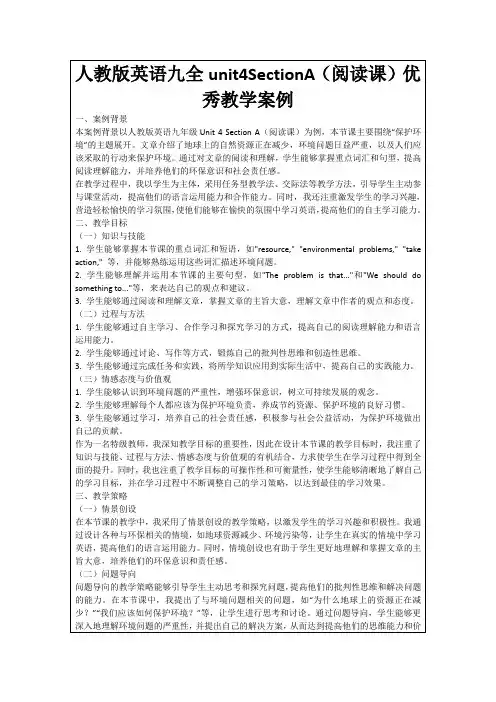
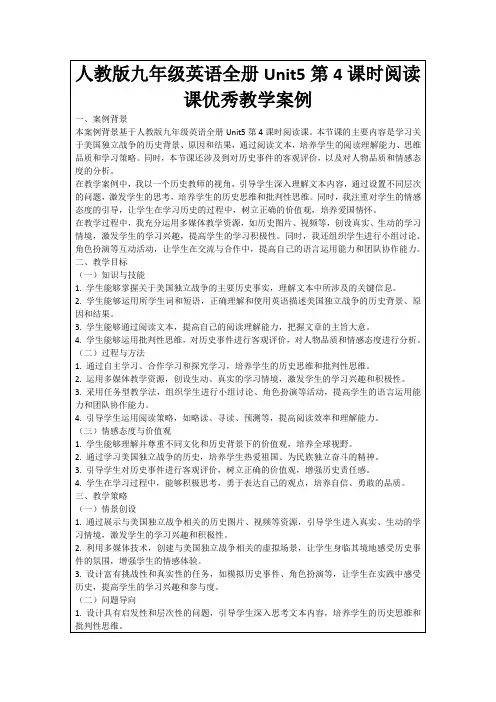
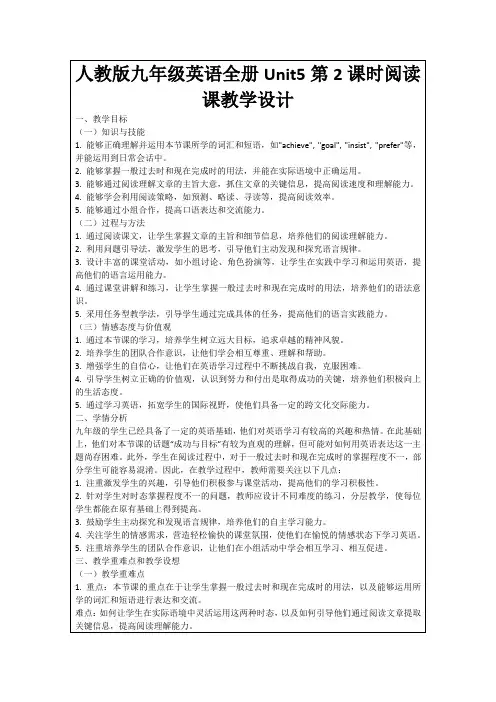
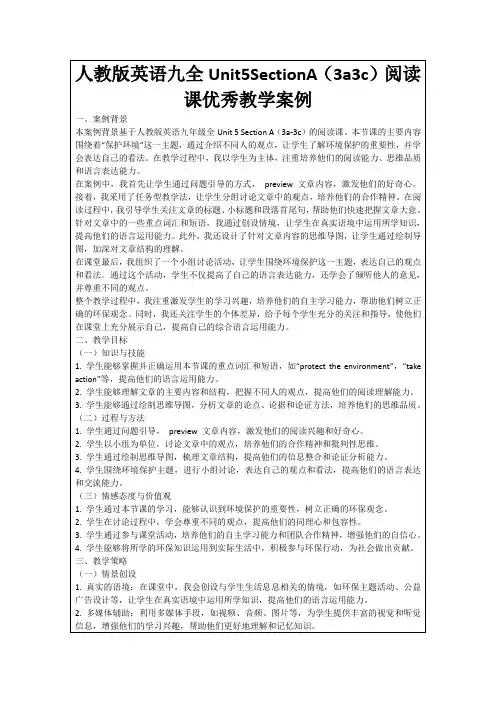
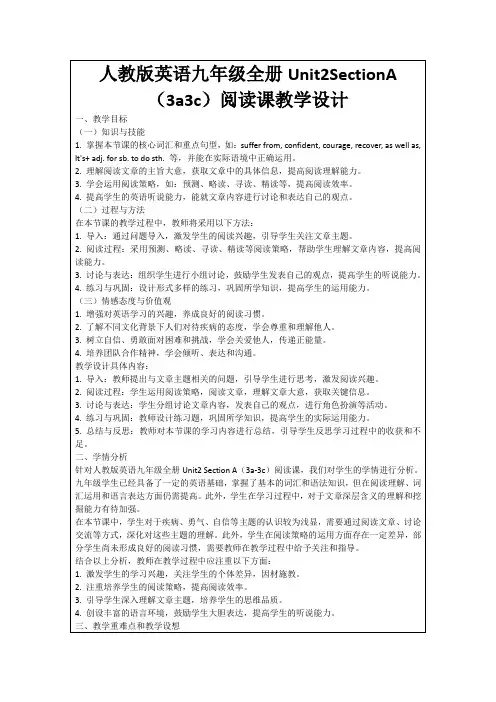
教学内容怎样提高学生阅读理解概括能力和解题能力?教学内容分析阅读理解能力的培养是中学英语学习的一项重要任务,也是中考的一项重要内容。
中考阅读理解题主要考查学生的语篇阅读能力、分析和判断力。
要求学生能较快地通过阅读理解短文大意,获取其中的主要信息,能做出正确判断,然后根据试题的要求从A, B, C三个选项中选出最佳答案或回答出所提问题等等,分值达到40分。
因此,学生英语阅读理解能力直接关系到中考的成败。
所以,中考复习时对学生进行阅读理解能力的指导是有必要的。
教学目标1. 知识和能力目标:1)了解英语中考阅读题型特点。
2)掌握英语阅读解题技巧,提高解题能力。
2. 情感目标:为创建美好的校园、家园尽一份力。
教学重难点掌握英语阅读解题技巧,提高解题能力教学方法复习、讨论、问答、讲解、归纳、总结等。
教学步骤Step 1 Free talk and lead in“创文创卫”是各市近几年的一项重要工作,尤其到年终的关键时刻,我们到处可以看到戴着红袖章的志愿者,他们站在寒风中维持着每天的交通顺畅,保护着我们所生存的家园干净整洁。
因此我抓住这个热门话题引入今天的阅读文章。
T: We are trying to make our city a National Civilized City. Look! Our streets are much cleaner and more beautiful thanks to them. Who are they?Ss: They are volunteers.T: Yes. They are students who volunteer.导入今天第一篇阅读材料。
Mario Green and Mary Brown from Riverside High School give up several hours each work to help others.Mary is a book lover. She could read by herself at the age of four. Last year, she decided to try out for a volunteer after-school reading program. She still works there once a week to help ki ds learn to read. “The kids are sitting in the library, but you can see in their eyes that they’re going on a different journey with each new book.Volunteering here is a dream comes true for me. I can do what I love to do and help others at the same time.”1. Mary loves reading, doesn’t she?2. What does Mary say about volunteering?T: Thanks to these volunteers, our city is becoming much more beautiful. But sometimes it looks like this (Show the students two pictures and present the two words: traffic jam and haze). So what can we do to cut down the pollution?Collect some answers from the students and lead to the topic: bike riding.交通拥堵和雾霾是目前很多城市所面临的两个大问题,政府以及市民都在为此而努力,公共自行车租赁就是其中最有效的方式之一。